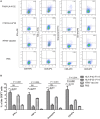Structure and Function of HLA-A*02-Restricted Hantaan Virus Cytotoxic T-Cell Epitope That Mediates Effective Protective Responses in HLA-A2.1/K(b) Transgenic Mice
- PMID: 27551282
- PMCID: PMC4976285
- DOI: 10.3389/fimmu.2016.00298
Structure and Function of HLA-A*02-Restricted Hantaan Virus Cytotoxic T-Cell Epitope That Mediates Effective Protective Responses in HLA-A2.1/K(b) Transgenic Mice
Abstract
Hantavirus infections cause severe emerging diseases in humans and are associated with high mortality rates; therefore, they have become a global public health concern. Our previous study showed that the CD8(+) T-cell epitope aa129-aa137 (FVVPILLKA, FA9) of the Hantaan virus (HTNV) nucleoprotein (NP), restricted by human leukocyte antigen (HLA)-A*02, induced specific CD8(+) T-cell responses that controlled HTNV infection in humans. However, the in vivo immunogenicity of peptide FA9 and the effect of FA9-specific CD8(+) T-cell immunity remain unclear. Here, based on a detailed structural analysis of the peptide FA9/HLA-A*0201 complex and functional investigations using HLA-A2.1/K(b) transgenic (Tg) mice, we found that the overall structure of the peptide FA9/HLA-A*0201 complex displayed a typical MHC class I fold with Val2 and Ala9 as primary anchor residues and Val3 and Leu7 as secondary anchor residues that allow peptide FA9 to bind tightly with an HLA-A*0201 molecule. Residues in the middle portion of peptide FA9 extruding out of the binding groove may be the sites that allow for recognition by T-cell receptors. Immunization with peptide FA9 in HLA-A2.1/K(b) Tg mice induced FA9-specific cytotoxic T-cell responses characterized by the induction of high expression levels of interferon-γ, tumor necrosis factor-α, granzyme B, and CD107a. In an HTNV challenge trial, significant reductions in the levels of both the antigens and the HTNV RNA loads were observed in the liver, spleen, and kidneys of Tg mice pre-vaccinated with peptide FA9. Thus, our findings highlight the ability of HTNV epitope-specific CD8(+) T-cell immunity to control HTNV and support the possibility that the HTNV-NP FA9 peptide, naturally processed in vivo in an HLA-A*02-restriction manner, may be a good candidate for the development HTNV peptide vaccines.
Keywords: CD8+ T-cell response; HLA-A*02; HLA-A2.1/Kb transgenic mice; Hantaan virus; crystal structure; cytotoxic T-cell epitope.
Figures






Similar articles
-
Protective CD8+ T-cell response against Hantaan virus infection induced by immunization with designed linear multi-epitope peptides in HLA-A2.1/Kb transgenic mice.Virol J. 2020 Oct 7;17(1):146. doi: 10.1186/s12985-020-01421-y. Virol J. 2020. PMID: 33028368 Free PMC article.
-
Novel Identified HLA-A*0201-Restricted Hantaan Virus Glycoprotein Cytotoxic T-Cell Epitopes Could Effectively Induce Protective Responses in HLA-A2.1/Kb Transgenic Mice May Associate with the Severity of Hemorrhagic Fever with Renal Syndrome.Front Immunol. 2017 Dec 12;8:1797. doi: 10.3389/fimmu.2017.01797. eCollection 2017. Front Immunol. 2017. PMID: 29312318 Free PMC article.
-
HLA-A2 and B35 restricted hantaan virus nucleoprotein CD8+ T-cell epitope-specific immune response correlates with milder disease in hemorrhagic fever with renal syndrome.PLoS Negl Trop Dis. 2013;7(2):e2076. doi: 10.1371/journal.pntd.0002076. Epub 2013 Feb 28. PLoS Negl Trop Dis. 2013. PMID: 23469304 Free PMC article.
-
Design and synthesis of HLA-A*02-restricted Hantaan virus multiple-antigenic peptide for CD8+ T cells.Virol J. 2020 Jan 31;17(1):15. doi: 10.1186/s12985-020-1290-x. Virol J. 2020. PMID: 32005266 Free PMC article.
-
HLA-E-restricted Hantaan virus-specific CD8+ T cell responses enhance the control of infection in hemorrhagic fever with renal syndrome.Biosaf Health. 2023 Jun 16;5(5):289-299. doi: 10.1016/j.bsheal.2023.06.002. eCollection 2023 Oct. Biosaf Health. 2023. PMID: 40078905 Free PMC article.
Cited by
-
HTNV infection of CD8+ T cells is associated with disease progression in HFRS patients.Commun Biol. 2021 Jun 2;4(1):652. doi: 10.1038/s42003-021-02182-2. Commun Biol. 2021. PMID: 34079056 Free PMC article.
-
Short peptide epitope design from hantaviruses causing HFRS.Bioinformation. 2017 Jul 31;13(7):231-236. doi: 10.6026/97320630013231. eCollection 2017. Bioinformation. 2017. PMID: 28943728 Free PMC article.
-
Screening and Identification of an H-2Kb-Restricted CTL Epitope within the Glycoprotein of Hantaan Virus.Front Cell Infect Microbiol. 2016 Nov 25;6:151. doi: 10.3389/fcimb.2016.00151. eCollection 2016. Front Cell Infect Microbiol. 2016. PMID: 27933274 Free PMC article.
-
Protective CD8+ T-cell response against Hantaan virus infection induced by immunization with designed linear multi-epitope peptides in HLA-A2.1/Kb transgenic mice.Virol J. 2020 Oct 7;17(1):146. doi: 10.1186/s12985-020-01421-y. Virol J. 2020. PMID: 33028368 Free PMC article.
-
IL-15 induced bystander activation of CD8+ T cells may mediate endothelium injury through NKG2D in Hantaan virus infection.Front Cell Infect Microbiol. 2022 Dec 15;12:1084841. doi: 10.3389/fcimb.2022.1084841. eCollection 2022. Front Cell Infect Microbiol. 2022. PMID: 36590594 Free PMC article.
References
LinkOut - more resources
Full Text Sources
Other Literature Sources
Research Materials
Miscellaneous

